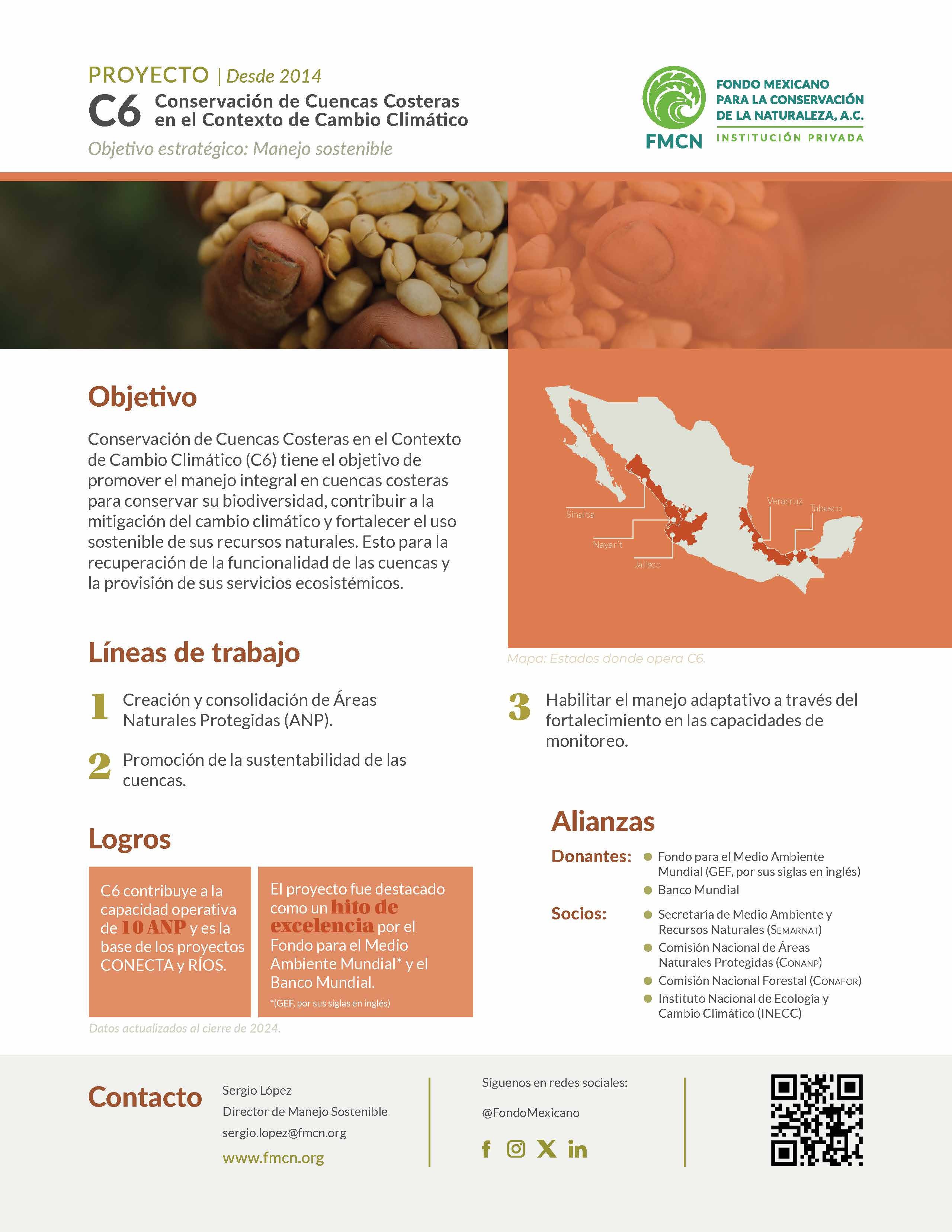Coastal Watershed Conservation in the Context of Climate Change (C6)
Promoting integrated management in coastal watersheds
The project
The Coastal Watershed Conservation in the Context of Climate Change (C6) project aims to promote integrated management in coastal watersheds to conserve their biodiversity, contribute to climate change mitigation and strengthen the sustainable use of their natural resources. This is for the recovery of watershed functionality and the provision of its ecosystem services.
Context
A coastal watershed is a territory delimited by a drainage basin, where a system of rivers converges and flows into the sea. Climate change scenarios in Mexico indicate that the coastal watersheds of the Gulf of Mexico and the continental part of the Gulf of California will be severely affected by increased droughts, hurricanes, and floods.
The C6 project had a successful operation between 2013 and 2018, during which it strengthened the management of ten Protected Areas (PAs) through the strategic use of patrimonial resources. It also fostered community participation and promoted collaboration with the Gulf of Mexico Fund (FGM, acronym in Spanish) and FONNOR (Northwestern and Western Fund). This partnership enabled the efficient and transparent use of resources, maximizing their impact on the territory.
Furthermore, the collaboration among three public institutions—the National Commission of Natural Protected Areas (Conanp, acronym in Spanish), the National Forestry Commission (Conafor, acronym in Spanish), and the National Institute of Ecology and Climate Change (INECC, acronym in Spanish)—and one private organization Mexican Fund for the Conservation of Nature (FMCN, acronym in Spanish) represented an innovative component aimed at fostering collaboration and coordination processes.
The lines of work that guide the actions of C6 are:
- Creation and consolidation of protected areas (PAs).
- Promotion of watersheds sustainability.
- Enabling adaptive management by strengthening monitoring capacities.
Coastal watersheds are an essential element for preserving biodiversity and reducing vulnerability to climate change.
Achievements
From March to May 2019, a team of international consultants evaluated the impact and effectiveness of the C6 project in the field, considering environmental, financial, and social aspects. The results are as follows: the C6 project involved collaboration with 30 civil society organizations, two regional funds, state and municipal authorities, and academic institutions to contribute to the integrated management of 16 coastal watersheds, an essential element for preserving biodiversity and reducing vulnerability to climate change. The project exceeded its goals due to the cooperation of all sectors and was highlighted as a milestone of excellence by the Global Environment Facility (GEF) and the World Bank.
Read the final evaluation of C6 here.
Throughout 2024, the project provided technical and administrative support for ten PAs, with an emphasis on strategic planning processes, experience-sharing events, project evaluations for funding eligibility, and the monitoring of requests and reports linked to the Emergency Fund.
One of the most relevant milestones in 2024 was the creation of a matching fund for payments for environmental services in the core areas of the Sierra de Vallejo – Río Ameca Biosphere Reserve, established by FONNOR, following the publication of the decree that created this new Protected Area.
In the second half of 2024, the project also actively supported the CONECTA, RÍOS, and ORIGEN programs. Both CONECTA and RÍOS carried out their independent midterm evaluations, showing significant progress in plot management and watershed planning. Coordination between FGM and FONNOR was key to achieving these results.
Additionally, the institutional development of FGM and FONNOR was strengthened. These two environmental funds play a strategic role in promoting alliances and programs with both the public and private sectors, aimed at environmental protection and the sustainable management of Mexico’s territory.
Allies
Donors:
- Global Environment Facility (GEF)
- World Bank
Partners:
- Ministry of Environment and Natural Resources
- National Commission of Natural Protected Areas
- National Forestry Commission
- Instituto Nacional de Ecología y Cambio Climático
